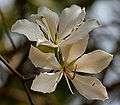Phanera variegata
| Orchid tree | |
|---|---|
 | |
| Flowers | |
| Scientific classification | |
| Kingdom: | Plantae |
| (unranked): | Angiosperms |
| (unranked): | Eudicots |
| (unranked): | Rosids |
| Order: | Fabales |
| Family: | Fabaceae |
| Genus: | Phanera |
| Species: | P. variegata |
| Binomial name | |
| Phanera variegata[1][2] (L.) Benth. | |
Phanera variegata is a species of flowering plant in the family Fabaceae, native to South Asia and Southeast Asia, from southern China, Burma, India, Nepal, Pakistan, and Sri Lanka. Common names include orchid tree, camel's foot tree, kachnar and mountain-ebony.
Description
It is a small to medium-sized tree growing to 10–12 metres (33–39 ft) tall, deciduous in the dry season. The leaves are 10–20 centimetres (3.9–7.9 in) obcordate shaped, long and broad, rounded, and bilobed at the base and apex. The flowers are conspicuous, bright pink or white, 8–12 centimetres (3.1–4.7 in) diameter, with five petals. The fruit is a pod 15–30 centimetres (5.9–11.8 in) long, containing several seeds.
In cultivation
This is a very popular ornamental tree in subtropical and tropical climates, grown for its scented flowers and also used as food item in South Asian cuisine. In the Neotropics, it can be used to attract hummingbirds—such as sapphire-spangled emerald (Amazilia lactea), glittering-bellied emerald (Chlorostilbon lucidus), or white-throated hummingbird (Leucochloris albicollis)—into gardens and parks.[3] On the other hand, in some areas it has become naturalised and invasive.
Gallery
.jpg) Habit of ornamental in Spain
Habit of ornamental in Spain 'camel-foot' foliage
'camel-foot' foliage var. candida in Hyderabad, India
var. candida in Hyderabad, India Seed pods and seeds — MHNT
Seed pods and seeds — MHNT
Uses as food
Kachnar is widely used as an ingredient in many Pakistani and Indian recipes. Traditional kachnar curry is prepared using kachnar buds, yogurt, onions and native Pakistani Indian spices which is delicious and good for health.
Footnotes
- ↑ Sinou C, Forest F, Lewis GP, Bruneau A (2009). "The genus Bauhinia s.l. (Leguminosae): a phylogeny based on the plastid trnL–trnF region". Botany. 87 (10): 947–960. doi:10.1139/B09-065.
- ↑ Wunderlin RP. (2010). "Reorganization of the Cercideae (Fabaceae: Caesalpinioideae)" (PDF). Phytoneuron. 48: 1–5.
- ↑ Baza Mendonça & dos Anjos (2005)
References
- Baza Mendonça, Luciana & dos Anjos, Luiz (2005): Beija-flores (Aves, Trochilidae) e seus recursos florais em uma área urbana do Sul do Brasil [Hummingbirds (Aves, Trochilidae) and their flowers in an urban area of southern Brazil]. [Portuguese with English abstract] Revista Brasileira de Zoologia 22(1): 51–59. doi:10.1590/S0101-81752005000100007 PDF fulltext
External links
| Wikimedia Commons has media related to Phanera variegata. |